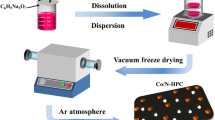Abstract
The development of lithium–sulfur batteries is limited due to its notorious "shuttle effect". Heteroatoms are introduced to the host materials to absorb the polysulfides and further to alleviate the shuttle effect. Herein, porous carbon (NSPC) was successfully prepared by template method and used as sulfur host material. The results show that NSPC has a high specific surface area (697.19 m2 g−1) and abundant heteroatom doping, which helps to enhance the capture and absorption of polysulfides. The prepared S@NSPC was loaded with 76% sulfur, and the composite electrode displayed excellent cycle stability because of its strong polysulfide absorption. The S@NSPC composite electrode shows high initial specific capacity of 741.8 mAh g−1 at 167.5 mA g−1, the capacity of the S@NSPC composite electrode remained 609.8 mAh g−1 after 500 cycles, and the attenuation per cycle was only 0.027%, showing good stability.









Similar content being viewed by others
References
Y.Y. Zhao, Y.S. Ye, F. Wu et al., Adv. Mater. 31, 1806532 (2019).
L. Borchardt, M. Oschatz, S. Kaskel et al., Chemistry 22, 7324 (2016).
S. Rehman, X.X. Gu, K. Khan et al., Adv. Energy Mater. 6, 1502518 (2016).
M. Jiang, R.X. Wang, K.L. Wang et al., Nanoscale 11, 15156 (2019).
Y.Z. Zhang, X.L. Zong, Z. Liang et al., Electrochim. Acta 284, 89 (2018).
X.B. Cheng, J.Q. Huang, Q. Zhang et al., Nano Energy 4, 65 (2014).
D.R. Deng, F. Xue, Y.J. Jia et al., ACS Nano 11, 6031 (2017).
J.J. Cai, Z.Y. Zhang, S.R. Yang et al., Electrochim. Acta 295, 900 (2019).
Z. Li, Y. Jiang, L.X. Yuan et al., ACS Nano 8, 9295 (2014).
X. Li, Y. Zhang, S. Wang et al., Nano Lett. 20, 701 (2020).
T.Y. Tang, T. Zhang, L.N. Zhao et al., Mater. Chem. Front. 4, 1483 (2020).
Z.T. Li, S.Z. Deng, R.F. Xu et al., Electrochim. Acta 252, 200 (2017).
M. Ding, S.Z. Huang, Y. Wang et al., J. Mater. Chem. A 7, 25078 (2019).
D. Cai, K.B. Liu, D.H. Zhu et al., Adv. Energy Mater. 10, 1904273 (2020).
D.Y. Guo, Z.H. Zhang, B. Xi et al., J. Mater. Chem. A. 8, 3834 (2020).
J. Gou, H.Z. Zhang, X.F. Yang et al., Adv. Funct. Mater. 28, 1707272 (2018).
J.Y. Lee, G.D. Park, J.C. Choia et al., Nanoscale Horizons 12, 2142 (2020).
J.N. Shi, Q. Kang, Y. Mi et al., Electrochim. Acta 19, 31720 (2019).
Z.J. Wang, J.J. Cheng, H.J. Song et al., Energy Technol. 7, 1900470 (2019).
M.Q. Du, Y.S. Meng, C. Wang et al., J. Electroanal. Chem. 834, 17 (2019).
Z. Chang, B. Ding, H. Dou et al., Chemistry 24, 3768 (2018).
M. Huang, J.Y. Yang, B.J. Xi et al., Sci. China Mater. 62, 455 (2018).
R. Fang, S. Zhao, S. Pei et al., ACS Nano 10, 8676 (2016).
J.T. Liu, S.H. Xiao, Z.Y. Zhang et al., Nanoscale. Horizons. 12, 5114 (2020).
Y.Z. Liu, G.R. Li, Z.W. Chen et al., J. Mater. Chem. A 5, 9775 (2017).
F. Zheng, Y. Yang, Q. Chen et al., Nat. Commun. 5, 5261 (2014).
W.T. Gu, M. Sevilla, A. Magasinski et al., Energy Environ. Sci. 6, 2465 (2013).
W.K. Ski, M. Szala, and M. Bystrzejewski, Carbon 68, 1 (2014).
Y.Z. Fu, and A. Manthiram, RSC Adv. 2, 5927 (2012).
C.J. Hu, Y.N. Chang, R.D. Chen et al., RSC Adv. 8, 37811 (2018).
C. Barchasz, F. Molton, C. Duboc et al., Anal. Chem. 84, 3973 (2012).
X. Liang, M.G. Zhang, M.R. Kaiser et al., Nano Energy 11, 587 (2015).
C.M. Xu, Y.S. Wu, X.Y. Zhao et al., J. Power Sources 275, 22 (2015).
J.H. Cheng, D. Zhao, L.S. Fan et al., Chemistry 24, 13253 (2018).
W.D. Zhou, C.M. Wang, Q.L. Zhang et al., Nano Energy 5, 356 (2015).
W.J. Ren, L.Q. Xu, L. Zhu et al., ACS. Appl. 10, 11642 (2018).
S.K. Park, J.K. Lee, Y.C. Kang et al., Adv. Func. Mater. 28, 1705264 (2018).
Acknowledgments
This work was supported by the National Natural Science Foundation of China (Grant No. 52064035) and the Natural Science Foundation of Gansu Province (Grant No. 20JR10RA166).
Author information
Authors and Affiliations
Corresponding author
Ethics declarations
Conflict of interest
No authors have any possible conflicts of interest.
Additional information
Publisher's Note
Springer Nature remains neutral with regard to jurisdictional claims in published maps and institutional affiliations.
Rights and permissions
About this article
Cite this article
Zhao, G., Meng, Y., Zhang, H. et al. One-Step Synthesis of N, S Co-doped Porous Carbon Use Ionic Liquid As Dopant for Lithium–Sulfur Batteries. J. Electron. Mater. 50, 6237–6244 (2021). https://doi.org/10.1007/s11664-021-09160-8
Received:
Accepted:
Published:
Issue Date:
DOI: https://doi.org/10.1007/s11664-021-09160-8




